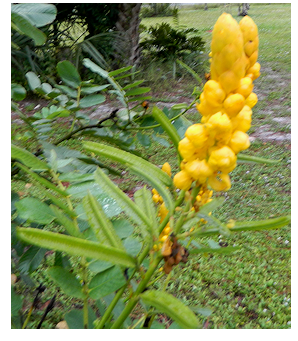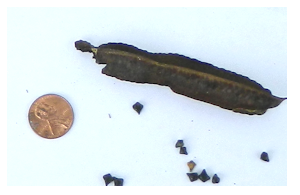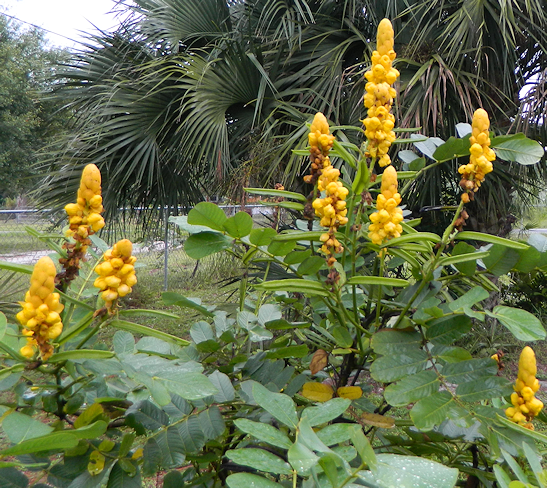 Cassia Alata is a very easy, fast growing plant that adds a beautiful pop of cheerful color to any garden.
Actually reclassified of late as a senna, it is native to Mexico, but grows very well here in the States. Although the plant can not take a hard frost, zones 8 and 9 should see the plant return from the roots in spring.
Cassia Alata is a very easy, fast growing plant that adds a beautiful pop of cheerful color to any garden.
Actually reclassified of late as a senna, it is native to Mexico, but grows very well here in the States. Although the plant can not take a hard frost, zones 8 and 9 should see the plant return from the roots in spring.
Senna Alata is also very easy to start from seed. Spring is the best time of year to do this. If you want a head start you can plant them out in flats inside under grow lights.
After the plant has flowered, it will begin to form long, green seed pods. (notice above picture, look under flowers) Within a month to 6 weeks, these pods will then turn dark brown to almost black, and you should be able to hear the seeds rattling around in them. This is the best time to pick the pods. Take a pair of scissors with you, as they can be hard to remove from the bush. If you don't already have access to a plant, you can buy the seeds online.
Start out the seed pots with pure vermiculite. Vermiculite holds water better than soilless mixtures, and because it is anti-bacterial, it will also keep fungus and algae from growing on the pot surface, as well as deter fungus gnats. It also holds water much better than soilless mixes (which are basically peat) so you will do less watering.
 Place seeds just under the surface, about 1/4 inch into the dampened vermiculite. Germination occurs within 7 days to 2 weeks with fresh seed. Allow the seedling to develop a set of true leaves before beginning a weak fertilizing schedule. Keep it in the seedling pot until you see roots appearing at the bottom of the pots. Then transfer each seedling into a one quart pot, with soilless mix. When roots fill that pot, transfer to a one gallon pot. When the roots fill that one, it can be placed in the ground if you so desire. Fertilize every two weeks for best growth, using a regular fert. The blue colored one made by Miracle-Gro works well.
Place seeds just under the surface, about 1/4 inch into the dampened vermiculite. Germination occurs within 7 days to 2 weeks with fresh seed. Allow the seedling to develop a set of true leaves before beginning a weak fertilizing schedule. Keep it in the seedling pot until you see roots appearing at the bottom of the pots. Then transfer each seedling into a one quart pot, with soilless mix. When roots fill that pot, transfer to a one gallon pot. When the roots fill that one, it can be placed in the ground if you so desire. Fertilize every two weeks for best growth, using a regular fert. The blue colored one made by Miracle-Gro works well.
Seed grown plants can flower the same year, even in colder climates. Although I live in South Florida, (so I get the benefit of no frost) I started mine from seed in October, and by June they were already blooming. Short season growers can either take the plant indoors, or re-seed from seed pods over the winter.

The Candelabra bush (as it is sometimes called) has lovely, soft leaves in an oval shape. They fold up in the evening. It can reach 10 feet in height, and the bush shape makes it ideal for hedging, row planting, or a few clumped together to create a dramatic stand-alone effect.
Senna Alata prefers moist soil, especially when it is young. The soil should contain sharp sand with some loamy material. Mulch the plant well to reserve water. Don't water the leaves if possible. After it is in-ground and established, you will not need to water it as often. Where I live, after one year, I don't have to water mine at all, the summer rains take care of that. In winter the plant slows down and the occassional rains we receive are enough to suffice.
Senna Alata also has the added benefit of preventing ringworm. In 2nd and 3rd world countries, the crushed leaves are still used to remove this pest from the skin of animals and humans alike. It can also be used as a strong laxative.
Candelabra bush is also a burtterfly attractor. The Giant Yellow Sulphur uses it not only for nectaring, but lays it's eggs on the plant. A few days later, lovely avocado and lemon striped caterpillars emerge. So if you like butterflies, this is another reason to try your hand at the lovely Senna Alata bush.
Tags: senna alata,, cassia alata

